#esc 1959
Text
Eurovision Fact #470:

The United Kingdom has been the runner up for first place more than any other nation with a total of 16 second place finishes.
Their first second place ranking came in 1959 thanks to Pearl Carr and Teddy Johnson and their song 'Sing Little Birdie.'
Their most recent second place finish came in 2022 thanks to Sam Ryder's 'Space Man.' This occurred after a long period of low rank and last place finishes for the UK.
[Source]
United Kingdom, Eurovision.tv.
#esc facts oc#eurovision#eurovision facts oc#eurovision song contest#esc#united kingdom#Pearl Carr and Teddy Johnson#Pearl Carr#Teddy Johnson#esc 1959#esc 2022#sam ryder
14 notes
·
View notes
Text
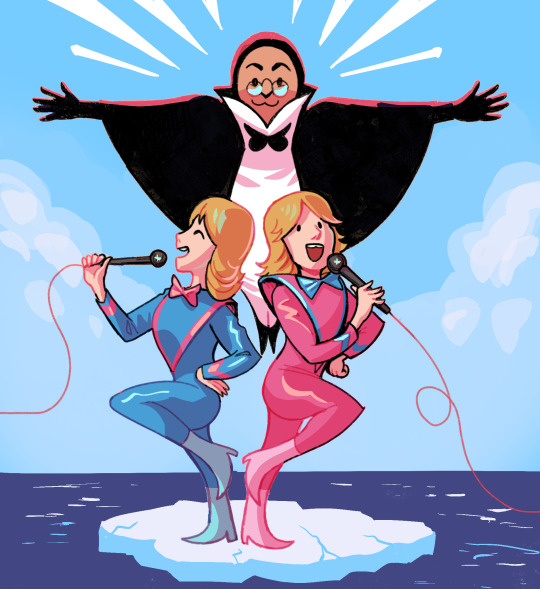
🇱🇺 Papa Pingouin - Sophie & Magaly
#Papa Pingouin#Sophie & Magaly#esc luxembourg#luxembourg esc#eurovision luxembourg#luxembourg eurovision#esc 1980#eurovision 1980#esc#eurovision#The second twins at eurovision after alice and ellen kessler (germany 1959) i think#neither of them is among us anymore... :(#at least we have this classic song to remember them#also can we talk about the costumes this year? we've JUST entered the 80s and everyone is going crazy on those 80s colours
52 notes
·
View notes
Text

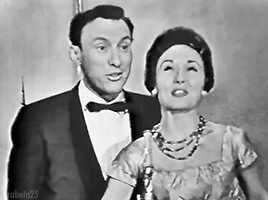
United Kingdom in the Eurovision Song Contest: The 1950′s
1957 - All, Patricia Bredin
1959 - Sing Little Birdie, Teddy Johnson & Pearl Carr
#eurovision#esc#uk#eurovision 1957#eurovision 1959#patricia bredin#teddy johnson & pearl carr#uk '57#uk '59#op#gif#50s#{country-decade}
2 notes
·
View notes
Note
I found out about Denmark's ESC entry from 1959 and now I'm vibing to it so hard 😭 I needed to tell that to a Dane
I went back and found it :3 the music gives me older Disney movies maybe especially Cinderella and Sleeping Beauty which fits with the time period - the lyrics are so cute tho, where she sings about how much she loves this other person and would love to spend her life with the person :'D
Thank you for the bit of love for our past entries :'3 ❤️🤍
2 notes
·
View notes
Note
Non è sulla lista, ma cosa è il tuo pezzo italiano preferito che è andato a Eurovision in questo secolo?
//
It's not on the list, but what is your favourite Italian song that went to Eurovision this century.
Apologies for my Italian 😅
Ciao!
Ah, you did great by trying! Just a suggestion: instead of "cosa è", next time try putting "qual è" (this latter form introduces a question about a choice generally, like the English "which is") :D
Okay, now, in the last century? Hmm... that's a tough choice.
I started following more accurately the ESC the first time Marco joined ten years ago, and the following year with Emma and "La mia città" I started commenting on here (this blog is THAT old LOL -I remember Twin Twin that year... sorry France and everyone but I kinda liked them haha!).
I realized in 1959 Domenico Modugno sang "Piove (Ciao Bambina)" which I used to sing a lot when I was a child so I should probably mention it (and Francesco Gabbani's Occidentali's Karma!). Yep, I'll say these two as my favs... keeping it Italian, also cause I might forget some songs I really loved from other countries (like last year's We are Domi's entry<3) :)
2 notes
·
View notes
Photo
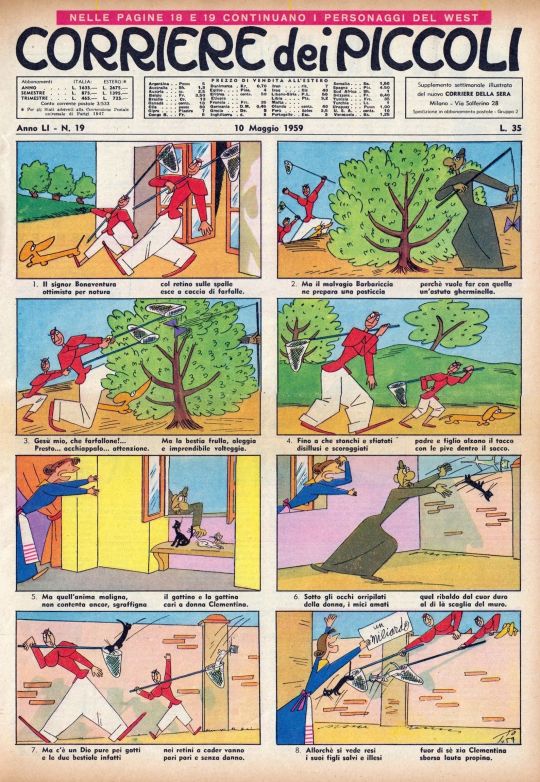
Il signor Bonaventura col retino sulle spalle esce a caccia di farfalle
Sergio Tofano
Tratto dal Corriere dei Piccoli nº 19 del 10 maggio 1959.
Oggi sul blog.
3 notes
·
View notes
Text
Winners ranking oof
Below the cut. I don't hate any of them, as a side note
Personal favorites
1. Fairytale (Norway 2009) - When I found out about this, around the time I became an eurofan in 2018, I was in awe. It's so catchy and fun and omg I love the violin. Perfect
2. Nocturne (Norway 1995) - Want my anxiety to drop down to 0? play this song at any given moment
3. Waterloo (Sweden 1974) - Schalger pop songs from the 70s are my weakness. And how can you not love ABBA?
4. Dansevise (Denmark 1963) - There's something so charming about this whole performance. The singers' stage presence, the flow of the song, the guitar, like idk man it's so beautiful...
5. Heroes (Sweden 2015) - 12 y/o me had her eyes glued to the screen when this was on stage and whenever I re-listen to this I feel the same feeling as I did back then. The first ever eurovision song that I was obsessed with!
6. Arcade (Netherlands 2019) - Nothing more to say. Loving you is a losing game is a huge icon at this point
7. Poupée de cire, poupée de son (Luxembourg 1965) - I love the beat and how bouncy and cheerful it sounds. Her entire career story is so heartbreaking though I couldn't not feel bad for her...
8. Zitti e Buoni (Italy 2021) - Never forget the edgy italian rockers 😔😔
9. Tu te reconnaîtras (Luxembourg 1973) - I get such a nostalgic feeling from this, it's as if I've heard this several times in my childhood before but I can't exactly remember. The piano bits are so lovely
10. Fångad av en stormvind (Sweden 1991) - Why is everyone so harsh on this song, I'll never understand...I love how energetic it is!! It's probably my favorite Carola song tbh (okay I also really like Främling but shhhh)
11. Een beetje (Netherlands 1959) - Cute sassy song that could fit so well in an old disney movie? Yes please
12. Insieme: 1992 (Italy 1990) - Ah yes, the superior "peace and unity" song that actually feels genuine. I swear I've heard this before in the past actually, like before I listened to the esc winners
13. Hallelujah (Israel 1979) - Yes guys bring me the harmonies
14. La det swinge (Norway 1985) - Groovy nordic pop from the 80s my beloved, I love their outfits a lot! 💜
15. A-ba-ni-bi (Israel 1978) - It's so catchy like whenever I listen to this I have it on loop for 5 days straight
16. Vivo Cantando (Spain 1969) - I love this one too! Out of the 4 winners this or Netherlands were the best imo
17. Save your kisses for me (United Kingdom 1976) - Being this wholesome should be illegal /j
18. Un banc, un arbre, une rue (Monaco 1971) - Same story as Tu te reconnaitras, I kind of have the same feelings for both, I get this strange, nostalgic yet comforting deja-vu when I listen to them
19. The Voice (Ireland 1996) - It's so magical and mysterious, teleports me to another world everytime I listen
20. Puppet on a string (United Kingdom 1967) - This feels so wholesome and sweet, I always like these kind of carnival themed songs for some reason
21. De Troubadour (Netherlands 1969) - Love how melancholic yet upbeat it sounds, and the guitar is just amazing
22. Apres toi (Luxembourg 1972) - Makes me feel emotions that I didn't even experience, how great this is...
23. Molitva (Serbia 2007) - It's so anthemic, I feel connected to this song on a personal level
24. Euphoria (Sweden 2012) - It's universally known as the best esc winner, and I do like it but feel that it's a bit too overhyped and all? haven't willingly listened to this for a while, even though I still admire the choreography and whole stage show, which was indeed amazing!
25. L'oiseau et l'enfant (France 1977) - Favorite french winner, hands down
Really like this ones
26. My number one (Greece 2005) - Grown a bit off me lately because I've been way too fixated on the retro winners but still a classic nonetheless. The stage show is just so perfect
27. Rise like a phoneix (Austria 2014) - Outstanding. I'm so impressed by the melody and especially the lyrics
28. Rock me baby (Yugoslavia 1989) - Underrated as heck, it's so funky and the message is interesting!
29. Diggi-loo Diggi-ley (Sweden 1984) - Diggiloo diggiley himlen öppnade sig yeah don't ask me I know the lyrics to this by heart
30. Net als toen (Netherlands 1957) - She looks like she's telling a whole life story, I love this
31. Nous les amoureux (Luxembourg 1961) - Yet another one that I didn't care about before, but when I gave it a try I really liked it. Didn't know he was actually singing about a same gender relationship?? In the early 60s??
32. Love Shine a Light (United Kingdom 1997) - Gives me a warm, comforting feeling, absolutely amazing
33. Boom bang-a-bang (United Kingdom 1969) - Yesss this is so cute as well, I love her expressions lol
34. Hold me now (Ireland 1987) - The superior Johnny Logan song
35. Ne partez pas sans moi (Switzerland 1988) - A literal queen, this was a no brainer win for that year
36. Refrain (Switzerland 1956) - Teleports me into the 50s. Oh to be a singer in the 50s...how would that be?
37. Ding-a-dong (Netherlands 1975) - The lyrics are incredibly silly, though the melody is super catchy
38. Only teardrops (Denmark 2013) - So beautiful, especially the flute.
These are good
39. 1944 (Ukraine 2016) - The glowy tree part always gives me the chills. I recently started to appreciate this more and the story behind the song is very tragic
40. Hard Rock Hallelujah (Finland 2006) - The costumes are 3 edgy 5 me but the song, oh yeah, the song's really great
41. J'aime la vie (Belgium 1986) - What a bop. kind of 80s generic music but I don't care
42. Non ho l'eta (Italy 1964) - The instrumental is pretty, however, since I discovered the lyrics I just...don't like it as much anymore. It's probably my least favorite italian winner if I'm being honest.
43. All kinds of everything (Ireland 1970) - Might have gotten diabetes over how sweet this song is
44. Merci, cherie (Austria 1966) - That bridge is beautiful as heck. underrated
45. What's Another Year (Ireland 1980) - Yeaaah, I like this a bit, feels kind of long at times tbh
46. Take me to your heaven (Sweden 1999) - Tend to overlook this one, I feel like it's not as fun as the other swedish schalgers from the past (Bra vibrationer, Fångad, Waterloo) but gave it a try recently and I sort of...liked it? Sure, not as much as the ones I mentioned earlier but it's solid tbh!
47. Wild Dances (Ukraine 2004) - The live version is very messy tbh, I listen to the studio more
48. Un jour, en enfant (France 1969) - I love how soft her voice is, but ultimately the song transforms into powerful vocals with an epic climax. The thing is that I don't really actively try to listen to this...
49. Stefania (Ukraine 2022) - Epic flute guy is back! Kind of grew off me, maybe if I'll relisten it might go some places up I guess
50. Ein bißchen frieden (Germany 1982) - Please it's so cozy campfire cottagecore aesthetic
Neutral, don't listen that much to them
51. Making your mind up (United Kingdom 1981) - So energetic and silly, 80s trash lolol
52. In your eyes (Ireland 1993) - My favorite out of the 3 back-to-back irish winners
53. Rock n roll kids (Ireland 1994) - One of the legendary irish wins, it's good I guess but not up my alley
54. Amar pelos dois (Portugal 2017) - Reminiscent of those classy 60s chansons which I appreciate, still kind of don't get out of my way to actively listen to this, though
55. I wanna (Latvia 2002) - The first winner that had something more on stage than just dancing. Love the outfit reveal lol
56. Everyway that I can (Turkey 2003) - Trash early 2000s ethnic pop at its finest
57. Satellite (Germany 2010) - ...I kind of used to listen to this at first since I found it quirky and fun, but now, along with some others I kind of forgot about it?
58. Fly on the wings of love (Denmark 2000) - Not exactly my favorite, but it's nice
59. Si la vie est cadeau (Luxembourg 1983) - Feels a bit bland I guess? But it's a good effort
60. Believe (Russia 2008) - Maybe I was influenced about the war, but this really fell down a loooot in my ranking. Epic ice skater guy is great, but I tend to dismiss this one as being a winner for some reason
61. La la la (Spain 1968) - It's repetitive as hell, but at least I like the verses more, right?
62. Tom Pillibi (France 1960) - Her singing can get a bit too high for my ears lmao but it's nice nonetheless
Don't care about them that much, sorry
63. Running scared (Azerbaijan 2011) - It's not bad per se, but I still ask myself how did this win. It lacks substance, any sort of charisma or dynamic between the two
64. Toy (Israel 2018) - I used to haaate this one back in 2018, then it kind of became a meme in my friend group. So I don't really know what to say about this one
65. Everybody (Estonia 2001) - Very funky, but sometimes I forget that this is one of the winners 😂
66. Diva (Israel 1998) - Listen Dana is amazing, but I feel that her song lacks something? She wasn't singing that great either. Don't really find myself listening to it that much so...
67. Dors mon amour (France 1958) - it's very calming, but feels like it drags on for too long I guess?
68. Un premier amour (France 1962) - why is it so repetitive help
69. Why me (Ireland 1992) - it's...too whiny and dramatic for me, sorry, it's the winner that I listened the least so far 😔
3 notes
·
View notes
Text
1 note
·
View note
Text
I'm reviewing two movies, this time based on fairy tales that have popular Disney versions but I'm not reviewing those, I'm instead reviewing the 1957's Snow Queen and 1959's 1001 Arabian Nights, starting with The Snow Queen (note ive watch the 1959 english dub with Art Linkletter).
_______________________________________
Kai and Gerda and two best friends who have a special bond with one another, one day during a cold winter night, they hear about the Snow Queen and Kai bets he could take her down however the Queen hears this and is like:
"Aw Hell Nah"
And it makes him impulsive, so it's easier to kidnap him, so Gerda has to go on a quest to save her friend from the cold and sterile Snow Queen.
_______________________________________

_______________________________________
This film's best thing is definitely its animation. It has a very disney-esce style but dials it just enough to distinct enough as an animated movie
_______________________________________

_______________________________________
There's also a nice message about being emotionally strong and that overcoming stuff like a metaphorical depression needs good friends who can be there for you.
_______________________________________

_______________________________________
A good example is when Gerda interacts with a kid from the pack of robbers who is edgy at first, but after hearing Gerda mission to save her friend, she decides to free all the animals she caught which is honestly pretty cute
_______________________________________

_______________________________________
So yeah, this movie is overall good now on to the next movie, 1001 Arabian Nights starring the near sighted Mr Magoo.
_______________________________________
Uncle Magoo tries hard to find a girl for Aladdin, but none of them strike his fancy, that is, until he sees the princess Yasminda, who is also having the attention of the villainous Wazir who also wants to marry her, after trying to get a lamp with Aladdin going along for the wealth idea,Al falls and discovers a genie and hijinks insue as Aladdin tries to get the princess's heart
_______________________________________
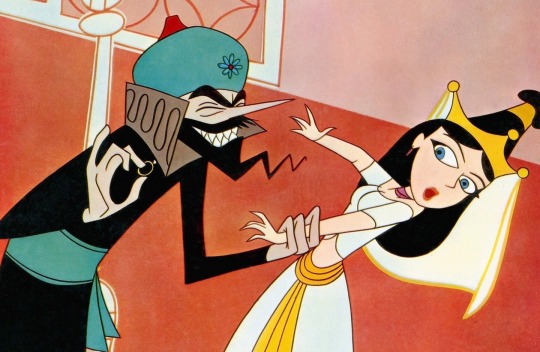
_______________________________________
Thus, it does feel kinda uneventful. There is definitely an interesting finale, but not much really much happens that is noteworthy enough to really mention. However, I will say that it can be pretty funny with Magoo's obliviousness being pretty funny
_______________________________________

_______________________________________
The film's animation, while not the best of the 1950s, is still nice with the geometric design choices, making its limited animation more forgivable.
_______________________________________

_______________________________________
Standout moments to me, including the Wazir going down to his lair and some of the Aladdin and Yasminda moments like at the love at first sight moment, those sequences were fun.
_______________________________________

_______________________________________
Overall kinda forgettable compared to the other 1001 Arabian Nights themed movies, but it's still okay as it is.
_______________________________________

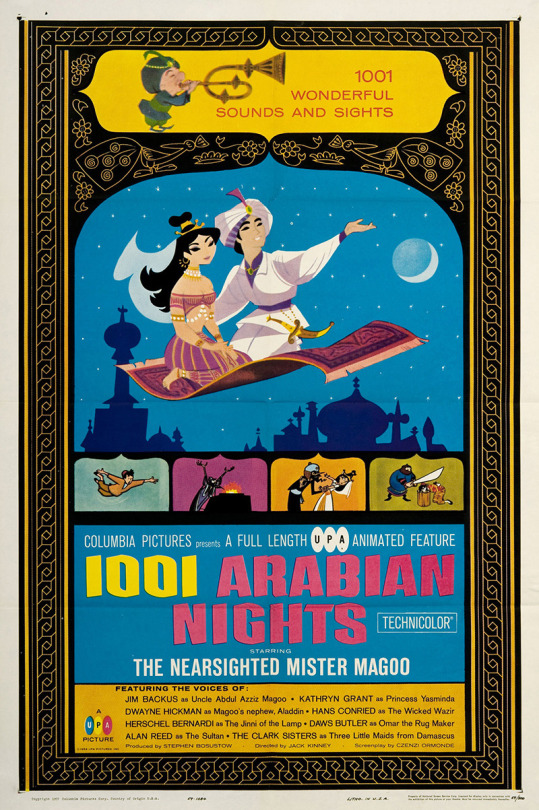
Overall Rating for both
The Snow Queen: 7/10
1001 Arabian Nights 6/10
0 notes
Text
"The Evolution of Automotive Safety: From Airbags to Autonomous Driving"
Introduction
The automotive industry has come a long way since the invention of the first automobile. Today, cars are not just a means of transportation but also a symbol of technological advancement and innovation. One of the most significant aspects of this evolution has been the constant improvement in car safety. From the early days of simple seatbelts to the current era of autonomous driving, the journey of automotive safety has been nothing short of remarkable.
In this comprehensive 2000-word article, we will explore the fascinating history of automotive safety, highlighting the major milestones, innovations, and technologies that have contributed to making cars safer than ever before.
Chapter 1: The Birth of Automotive Safety
In the early days of the automobile industry, safety was not a top priority. Cars were seen as novelties, and their designs and features were rudimentary compared to today's standards. However, as accidents became more common, the need for safety measures became apparent.
1.1 The First Seatbelts
One of the earliest safety features in automobiles was the seatbelt. In 1885, the first seatbelt patent was granted to Edward J. Claghorn of New York. These early seatbelts were not like the modern ones we know today. Instead, they were more like harnesses designed to keep passengers in their seats during bumpy rides.
1.2 The Invention of the Crumple Zone
In 1952, Mercedes-Benz engineer Béla Barényi introduced the concept of the crumple zone. This revolutionary idea involved designing the front end of the car to absorb energy during a collision, thereby reducing the impact on passengers. The crumple zone was a significant leap forward in automotive safety.
Chapter 2: The Rise of Passive Safety Systems
As the automotive industry continued to grow, so did the emphasis on safety. The 1950s and 1960s saw the introduction of several passive safety systems that aimed to protect passengers in the event of a collision.
2.1 The Three-Point Seatbelt
In 1959, Nils Bohlin, an engineer at Volvo, invented the three-point seatbelt. This design featured a lap belt and a diagonal shoulder belt, providing much greater protection than earlier seatbelt designs. Volvo made the patent open to other automakers, leading to widespread adoption of this life-saving technology.
2.2 The Airbag Revolution
The 1970s saw the introduction of airbags in cars. Initially used as an experimental safety feature, airbags quickly became standard equipment in most vehicles. These inflatable cushions deploy upon impact, significantly reducing the risk of head and chest injuries during a collision.
Chapter 3: Active Safety Systems and Electronics
With advancements in technology, automotive safety evolved beyond passive systems. The integration of electronics and computer systems led to the development of active safety features that could help prevent accidents altogether.
3.1 Anti-Lock Brakes (ABS)
In the 1980s, anti-lock brake systems (ABS) became widely available. ABS sensors monitor wheel speed and prevent skidding during hard braking. This innovation allowed drivers to maintain steering control even in slippery conditions, reducing the risk of accidents.
3.2 Electronic Stability Control (ESC)
Electronic stability control systems, introduced in the 1990s, use sensors to detect when a vehicle is losing control and apply brakes to individual wheels to help stabilize it. ESC has been credited with reducing the number of single-vehicle accidents caused by loss of control.
Chapter 4: The Road to Autonomous Driving
The 21st century brought about the dawn of autonomous driving, a technological leap that holds the promise of significantly reducing accidents and fatalities on the road.
4.1 Adaptive Cruise Control (ACC)
Adaptive cruise control systems, first introduced in luxury vehicles, use radar and sensors to maintain a safe following distance from the vehicle in front. This technology not only reduces driver fatigue but also helps prevent rear-end collisions.
4.2 Lane Keeping Assist (LKA)
Lane keeping assist systems use cameras and sensors to detect lane markings and keep the vehicle within the lane. If the car starts to drift out of the lane without the turn signal activated, the system can apply gentle steering input to keep it on course.
4.3 Collision Avoidance Systems
Modern cars are equipped with collision avoidance systems that can detect obstacles, pedestrians, and other vehicles in their path. These systems can provide warnings to the driver and even intervene by applying the brakes or steering to avoid a collision.
4.4 The Quest for Full Autonomy
Companies like Tesla, Waymo, and General Motors are actively working on achieving full autonomy
1 note
·
View note
Text
Artist Research - Vivienne Westwood
24 February 2023

In the late 1960s, the hippie culture and fashion became the most popular thing at the time. Despite this, Vivienne Westwood and Malcolm McLauren steered away from this concept. They were far more interested in typical 1950s clothing, music, rebellion and memorabilia.
Making Teddy Boy clothes for Malcolm was how Vivienne first started designing and in 1971 they opened a small boutique called Let it Rock at number 430 Kings Road, Chelsea in London.
However, the style changed after a year. Vivienne started to design with biker clothing, leather and zips. A skull and crossbones were used to re-brand the shop and they changed the name to;Too Fast to Live, Too Young to Die.
Vivienne and Malcolm were persecuted under the 1959 Obscene Publications Act after they started designing their own t-shirts with provocative printed slogans. They responded by producing even more t-shirts with hard-core images and re-branding the shop again.
By 1974 the shop was renamed Sex, a shop “unlike anything else going on in England at the time” and their slogan was; ‘rubberwear for the office’.



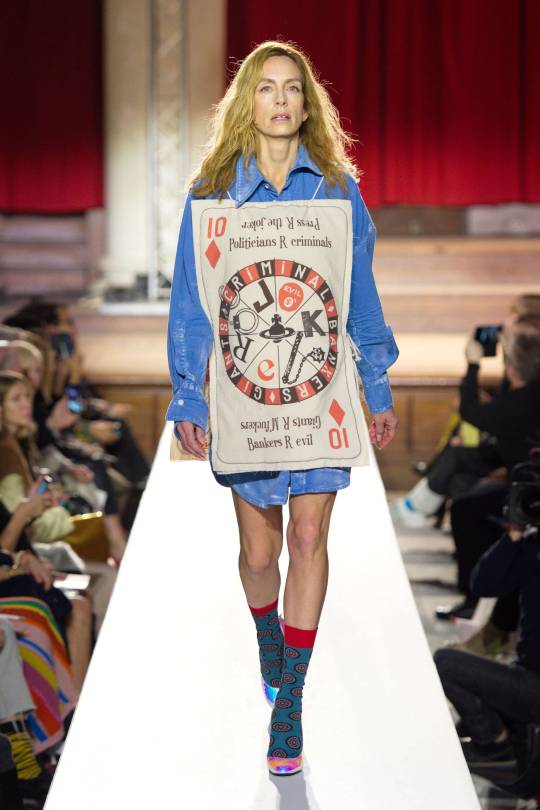




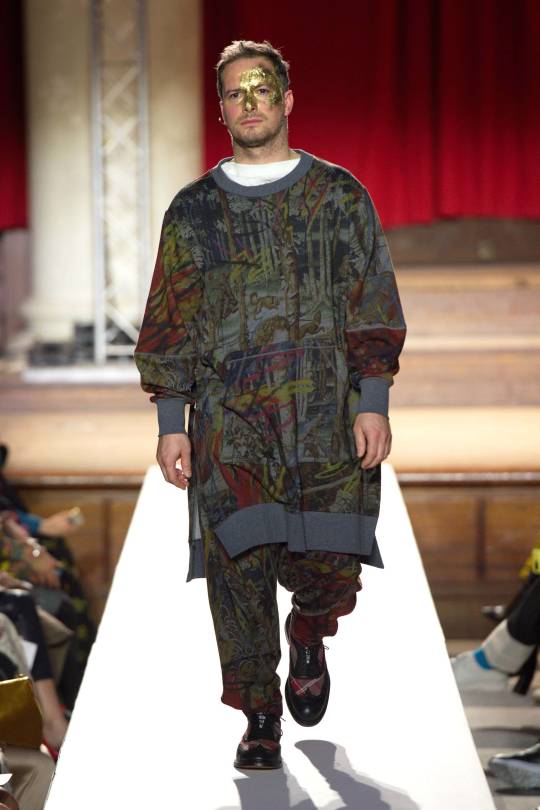
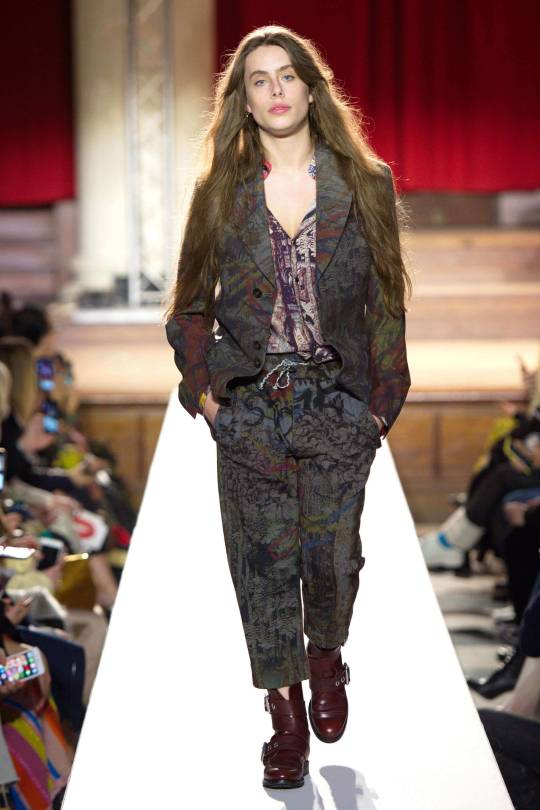


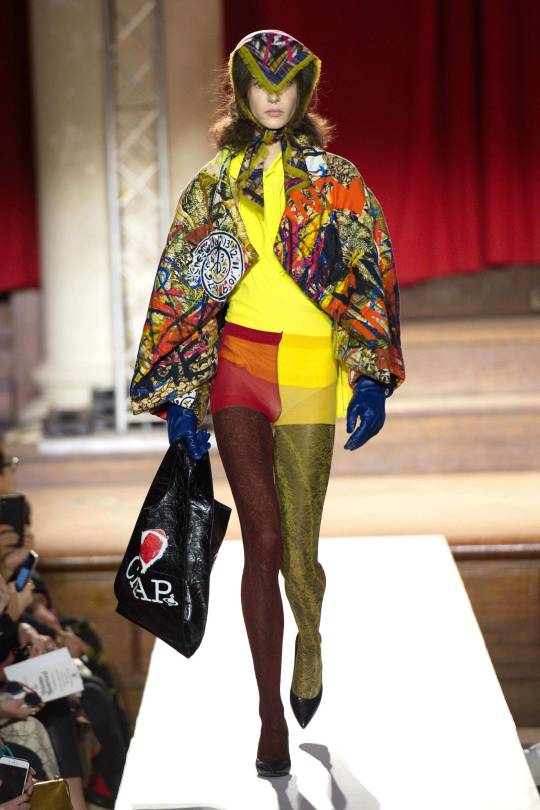

I really like the way she uses graffiti esc patterns to create a sense of noise and atmosphere and chaos to the garments. All of which indicate to the emotions of the crowd. I think I would like to use this concept to inspire some designs I will create.
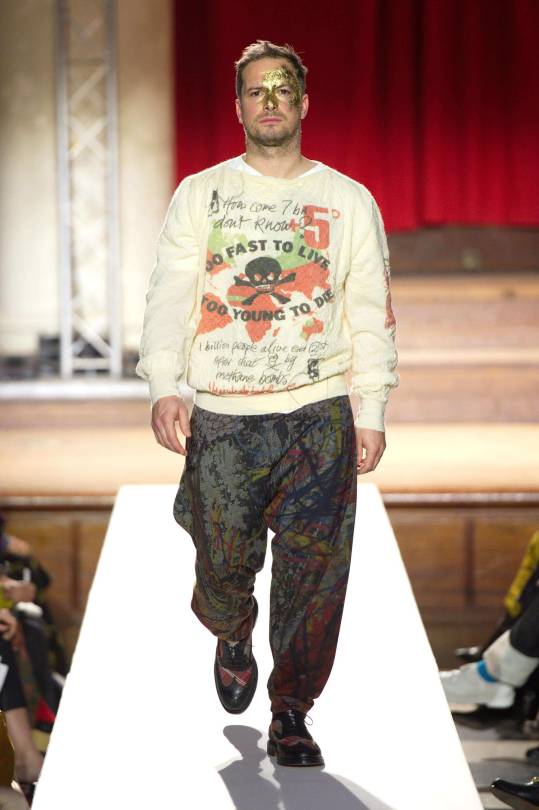

I also find the idea of using an item of clothing that can be seen as a symbol of oppression for women (apron), and turning it into a way of protesting to be intriguing and clever as it sends a clear message about what is wrong with society.
SS19


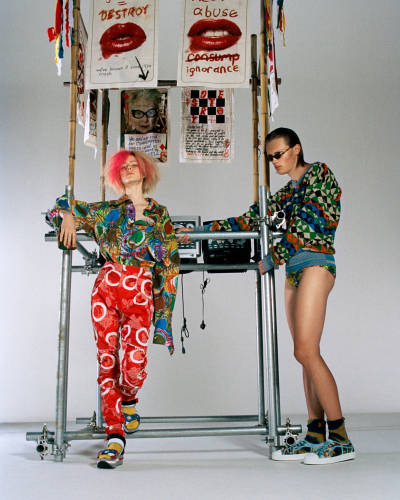

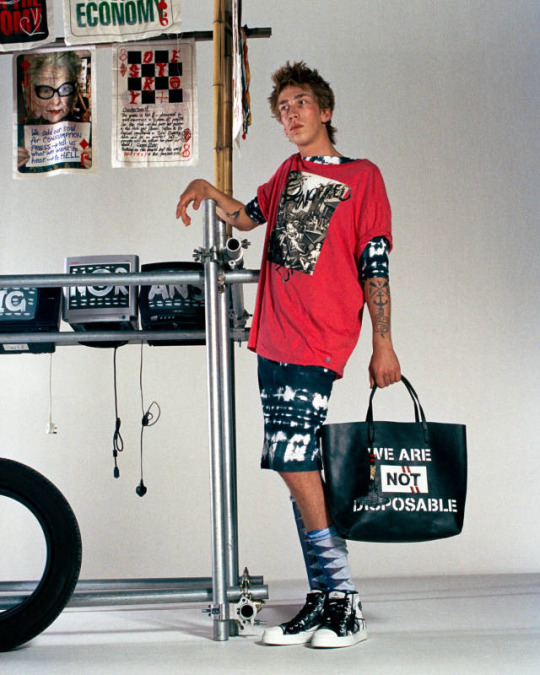
I really like the bright colours and the the patterns that Westwood used for this collection as it portrays the strong emotions that the people evoke. I also think it can represent the danger that the issues pose upon people, it is often seen in the jungle, where animals have bright colours to ward off predetors.
0 notes
Note
With twins returning to Eurovision this year via Azerbaijan, we need some twin participant facts: how many, the first (Germany 1959, both still alive), the sad story of Sophie and Magaly, the fact that Netherlands 2021 had twins, etc.
Eurovision Fact #337:
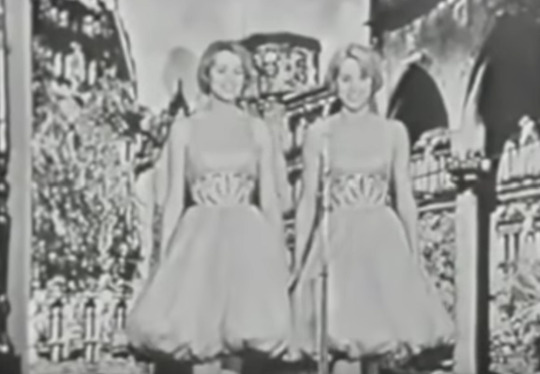
Germany's 1959 representatives, Alice and Ellen Kessler, were the first twins to ever perform in the Eurovision Song Contest. The duo is most famous for their dancing abilities, and have appeared in many films in the 50s and 60s. Their song 'Heut' Woll'n Wir Tanzen Geh'n' placed 8th overall.
The Kesslers started their careers in 1942 and are still active actors today.
The twins' were very popular in the United States in the late 50s and 60s, but remain heavily popular in their native Germany and Italy.
In fact, when they agreed to be on the cover of the Italian edition of Playboy at the age of 40, that edition of the magazine sold more copies than any other edition in history, and the record still stands.
[Sources]
Participants of Cannes 1959: Alice and Ellen Kessler, Eurovision.tv.
Kessler Twins, Wikipedia.org.
Alice Kessler, IMDb.com.
Ellen Kessler, IMDb.com.
'Perché le gambe delle gemelle Kessler erano il sogno di tutte? La vera storia delle dive della tv italiana,' elle.com.
#Thanks so much for the request!#There's a lot of great info in your ask so I hope you don't mind me breaking it down into a few facts!#esc#eurovision facts oc#esc facts oc#eurovision song contest#eurovision#esc 1959#kessler twins#alice kessler#ellen kessler
13 notes
·
View notes
Text
Ucraina, ballata di Capossela contro tutte le guerre
(ANSA) – ROMA, 23 FEB – Esce domani, venerdì 24 febbraio, La
crociata dei bambini, il nuovo brano di Vinicio Capossela che
riparte dal poema di Bertolt Brecht “La crociata dei ragazzi”
(1942, in Italia edito da Einaudi nel 1959), per affrontare “la
peggiore delle catastrofi: la guerra, con tutto il corollario di
avvelenamento, di semplificazione, di inflazione, di
vanificazione di ogni sforzo…
View On WordPress
0 notes
Text
youtube
Uh-jeg Ville Ønske Jeg Var Dig, Birthe Wilke | Denmark, Eurovision Song Contest Grand Prix Eurovision de la Chanson Européene 1959
5th place with 12 points
1 note
·
View note
Text
Classic Car Dealers Tampa - mmclassicauto
Classic Car Chevy: The History, Facts and Fun Stuff
Chevy is one of the most iconic American brands, and their cars have left an enduring legacy in automotive history. In this blog post, we will explore the history, facts and fun stuff about Chevy cars. We'll discuss everything from their early years to their latest models and show you just why they're so popular. So sit back, relax and let us take you on a ride down memory lane with some classic Chevy car trivia. Classic Car Dealers Tampa
Chevy Classic Cars
Chevy Classic Cars
The Chevy classic car is one of the best-selling cars in the world, and for good reason. The design is iconic, the engineering is top-notch, and there’s something timeless about these cars that makes them popular with drivers and collectors alike. Here are some interesting facts about Chevy classic cars:
1. The first Chevy classic car was introduced in 1937 as a six-cylinder model.
2. Chevrolet became a major player in the muscle car market in the 1960s with models like the Camaro and Corvette.
3. Production of classic Chevys ended in 1985 but they continued to be sold through specialty dealers until 2002.
4. Many famous drivers have owned or driven a Chevy classic car including Steve McQueen, Richard Petty and Dan Gurney.
The 1960s Chevy Bel Air
The 1960s Chevy Bel Air was America's dream car. It epitomized everything that was cool and stylish during that decade. This magnificent machine was big, bold and beautiful. It had a powerful engine and luxurious features such as an automatic transmission and air conditioning.
The Chevrolet Bel Air was first introduced in 1953 as the sporty coupe version of the Chevrolet Impala. The Bel Air name debuted on the 1957 model year car and it quickly became one of Chevrolet's most popular models. The 1959 model year saw a new option for the Bel Air - a convertible body style.
Over its lifespan, the Chevy Bel Air underwent several design changes to keep up with changing trends. The 1960s saw an increase in popularity for muscle cars, so the Bel Air got bigger and badder. It also received new options such as a power sunroof and leather interior seating.
Overall, the Chevy Bel Air was a very popular car during the 1960s. It appealed to people of all ages because it embodied all the things that were trendy at that time - style, luxury and performance. Thanks to its timeless appeal, the Chevy Bel Air remains one of Chevrolet's most iconic models today!
1970s Chevy Chevelle
The 1970s were a time of change for Chevrolet. After several years of product stagnation, the company was looking to recapture its former glory. One way to do this was by introducing new models and design ideas into their lineup.
One such model was the Chevelle. Introduced in February 1970, it marked a departure from the traditional Chevy design language. Gone were the blunt lines and round shapes that had characterized earlier cars. The Chevelle was sleek and modern, with angular lines and a sharply pointed nose.
Its exterior was only part of the story; under the hood lurked a powerful engine that would make it one of Chevrolet's most popular models ever. Available in both coupe and convertible form, the Chevelle offered drivers excellent performance and style in equal measure.
In addition to its looks, the Chevelle also had plenty of features that made it stand out from other cars on the market at the time. For example, it featured an electronic stability control system (ESC) which helped keep drivers safe during high-speed collisions. And because it was built on a sturdy platform, the Chevelle could take a lot of punishment without breaking down – making it perfect for those who loved driving fast but didn't want to worry about their car's reliability whatsoever.
1 note
·
View note
Text
I’ve been watching through the old contests and yesterday, while watching the 1959 contest, I came to the realization that “Solovey” (Ukraine 2020) feels a bit like the antithesis of “Sing, Little Birdie” (UK 1959).
“Sing, Little Birdie” is about a couple who are unabashedly in love with each other and very open about it, encouraging the bird in the song to “sing, and help our love along.”
“Solovey”, meanwhile, is about loving someone in secret and not wanting anyone (especially the singer’s mother) to know about it, begging the nightingale to “not sing so early.”
I just found that kinda neat!
#eurovision#eurovision song contest#eurovision 2020#eurovision song contest 2020#esc 2020#eurovision 1959#eurovision song contest 1959#esc 1959#esc ukraine#esc united kingdom#esc uk#go_a#solovey#pearl carr#teddy johnson#pearl carr & teddy johnson#pearl carr and teddy johnson#sing little birdie
26 notes
·
View notes